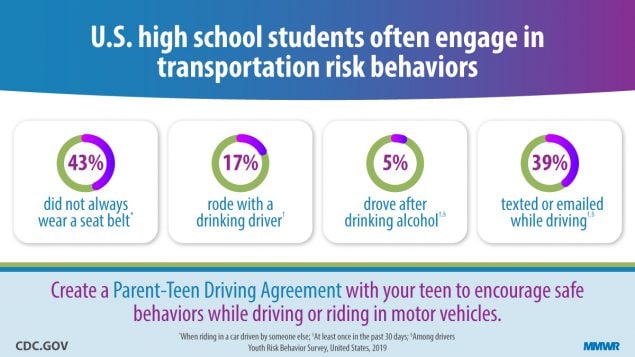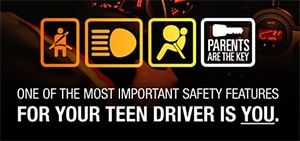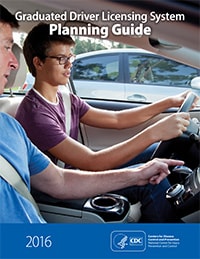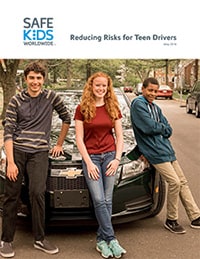Publications

Motor vehicle crash injuries are a leading cause of death and nonfatal injury among adolescents. In 2019, 43.1% of U.S. high school students did not always wear a seat belt as a passenger, and 16.7% rode with a driver who had been drinking alcohol during the past 30 days. Of the approximately 60% of students who drove a car during the past 30 days, 5.4% drove after drinking alcohol, and 39.0% texted or e-mailed while driving at least once during the past 30 days. Also, students engaging in one transportation risk behavior were more likely to engage in other transportation risk behaviors. Reducing risky transportation behaviors among adolescents by using proven strategies (e.g., primary enforcement seat belt laws, publicized sobriety checkpoints, and parent-teen driving agreements) can help prevent crashes, reduce injuries, and save lives.
Teen crash fatality rates differ by geographic location. Data from 2015 and 2017 national Youth Risk Behavior Surveys were combined and analyzed to explore the role of census region and metropolitan status for driving prevalence and four transportation risk behaviors among U.S. public high school students. This study found:
- 41% of students did not always wear a seat belt. Students in the Northeast were 40% more likely than students in the Midwest to not always wear a seat belt.
- Among the 75% of students (ages ≥16) who drove, 47% texted/e-mailed while driving during the 30 days before the survey. Students in the Northeast were 20% less likely than students in the Midwest to text/e-mail while driving. Students attending suburban or town schools were 20%–30% more likely to text/e-mail while driving than students attending urban schools.
- 19% of students rode with a driver who had been drinking alcohol during the 30 days before the survey, and 7% of students (ages ≥16) who drove did so when they had been drinking alcohol, with no differences by location for either behavior.
There were few differences in teen transportation risk behaviors by geographic location. Factors such as age at licensure, time since licensure, driving experience, and the policy and physical driving environment might contribute more to variation in teen crash fatality rates by geographic location than differences in teen transportation risk behaviors.
- Shults RA, Shaw KM, Yellman MA, Jones SE. Does geographic location matter for transportation risk behaviors among U.S. public high school students?. J Transp Health. 2021;22:10.1016/j.jth.2021.101134. doi:10.1016/j.jth.2021.101134
- Shults RA, Jones JM, Komatsu KK, Sauber-Schatz EK. Alcohol and marijuana use among young injured drivers in Arizona, 2008–2014. Traffic Inj Prev. 2019;20(1):9–14. doi:10.1080/15389588.2018.1527032
- Li L, Shults RA, Andridge RR, Yellman MA, Xiang H, Zhu M. Texting/Emailing While Driving Among High School Students in 35 States, United States, 2015. J Adolesc Health. 2018;63(6):701–708. doi:10.1016/j.jadohealth.2018.06.010
- Shults RA, Bergen G, Smith TJ, Cook L, Kindelberger J, West B. Characteristics of Single Vehicle Crashes with a Teen Driver in South Carolina, 2005–2008. Accid Anal Prev. 2019;122:325–331. doi:10.1016/j.aap.2017.08.002
- Shults RA, Williams AF. Trends in teen driver licensure, driving patterns and crash involvement in the United States, 2006–2015. J Safety Res. 2017;62:181–184. doi:10.1016/j.jsr.2017.06.013
- Jewett A, Shults RA, Bhat G. Parental Perceptions of Teen Driving: Restrictions, Worry and Influence. J Safety Res. 2016;59:119–123. doi:10.1016/j.jsr.2016.09.003
- Shults RA, Haegerich TM, Bhat G, Zhang X. Teens and seat belt use: What makes them click?. J Safety Res. 2016;57:19–25. doi:10.1016/j.jsr.2016.03.003
- Haegerich TM, Shults RA, Oman RF, Vesely SK. The Predictive Influence of Youth Assets on Drinking and Driving Behaviors in Adolescence and Young Adulthood. J Prim Prev. 2016;37(3):231–245. doi:10.1007/s10935-016-0418-7
- Shults RA, Banerjee T, Perry T. Who’s not driving among U.S. high school seniors: A closer look at race/ethnicity, socioeconomic factors, and driving status. Traffic Inj Prev. 2016;17(8):803–809. doi:10.1080/15389588.2016.1161761
- Dellinger AM, West BA. Health Care providers and Teen Driving Safety: Topics Discussed and Educational Resources Used in Practice. Am J Lifestyle Med. 2015;9(6):451–456. doi:10.1177/1559827614554903
- Shults RA, West BA. ATV riding and helmet use among youth aged 12–17 years, USA, 2011: results from the YouthStyles survey. Inj Prev. 2015;21(1):10–14. doi:10.1136/injuryprev-2013-041138
- Shults RA, Williams AF. Trends in driver licensing status and driving among high school seniors in the United States, 1996–2010. J Safety Res. 2013;46:167–170. doi:10.1016/j.jsr.2013.04.003
- Olsen EO, Shults RA, Eaton DK. Texting While Driving and Other Risky Motor Vehicle Behaviors Among US High School Students. Pediatrics. 2013;131(6):e1708–e1715. doi:10.1542/peds.2012-3462
- Gill SK, Shults RA, Cope JR, Cunningham TJ, Freelon B. Teen driving in rural North Dakota: a qualitative look at parental perceptions. Accid Anal Prev. 2013;54:114–121. doi:10.1016/j.aap.2013.02.010
- Williams AF, West BA, Shults RA. Fatal Crashes of 16- to 17-Year-Old Drivers Involving Alcohol, Nighttime Driving, and Passengers. Traffic Inj Prev. 2012;13(1):1–6. doi:10.1080/15389588.2011.633235
- Olsen EO, Hertz MF, Shults RA, Hamburger ME, Lowry R. Healthy People 2010 objectives for unintentional injury and violence among adolescents. Trends from the National Youth Risk Behavior Survey, 1999-2009. Am J Prev Med. 2011;41(6):551–558. doi:10.1016/j.amepre.2011.08.011
- Williams AF, Ali B, Shults RA. The Contribution of Fatal Crashes Involving Teens Transporting Teens. Traffic Inj Prev. 2010;11(6):567–572. doi:10.1080/15389588.2010.501834
- Williams AF, Shults RA. Graduated Driver Licensing Research, 2007–Present: A Review and Commentary. J Safety Res. 2010;41(2):77–84. doi:10.1016/j.jsr.2010.03.002
- Shults RA. Foreword to “Graduated Driver Licensing Research, 2007–Present: A Review and Commentary”. J Safety Res. 2010;41(2):75. doi:10.1016/j.jsr.2010.04.001
- Jones SE, Shults RA. Trends and Subgroup Differences in Transportation-Related Injury Risk and Safety Behaviors Among US High School Students, 1991-2007. J Sch Health. 2009;79(4):169–176. doi:10.1111/j.1746-1561.2008.00386.x
- Hedlund J, Shults RA, Compton R. Graduated driver licensing and teenage driver research in 2006. J Safety Res. 2006;37(2):107–121. doi:10.1016/j.jsr.2006.02.001
- Hedlund J, Shults RA, Compton R. What we know, what we don’t know, and what we need to know about graduated driver licensing. J Safety Res. 2003;34(1):107-115. doi:10.1016/s0022-4375(00)0865
- Everett SA, Shults RA, Barrios LC, Sacks JJ, Lowry R, Oeltmann J. Trends and subgroup differences in transportation-related injury risk and safety behaviors among high school students, 1991–1997. J Adolesc Health. 2001;28(3):228–234. doi:10.1016/s1054-139x(00)00177-4
- Yellman MA, Bryan L, Sauber-Schatz EK, Brener N. Transportation Risk Behaviors Among High School Students — Youth Risk Behavior Survey, United States, 2019. MMWR Suppl. 2020;69(1):77–83. doi:10.15585/mmwr.su6901a9
- Shults RA, Williams AF. Graduated Driver Licensing Night Driving Restrictions and Drivers Aged 16 or 17 Years Involved in Fatal Night Crashes — United States, 2009–2014. MMWR Morb Mortal Wkly Rep. 2016;65(29):725–730. doi:10.15585/mmwr.mm6529a1
- Shults RA, Olsen E, Williams AF. Driving Among High School Students — United States, 2013. MMWR Morb Mortal Wkly Rep. 2015;64(12):313–317.
- Shults RA, Olsen EO. Vital Signs: Drinking and Driving Among High School Students Aged ≥16 Years — United States, 1991–2011. MMWR Morb Mortal Wkly Rep. 2012;61(39):796–800.

Parents Are the Key to Safe Teen Driving
Parents Are the Key materials can help parents, pediatricians, and communities keep teen drivers safe on the road.

Graduated Driver Licensing (GDL) System Planning Guide
The GDL Planning Guide can assist states to assess, develop, and implement actionable plans to strengthen graduated driver licensing practices.

Reducing Risks for Teen Drivers
Safe Kids Worldwide report “Reducing Risks for Teen Drivers” explores how families are managing the risks new drivers face and suggests strategies that families can put into place to help keep teen drivers safe.